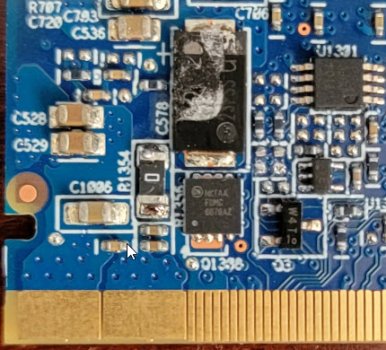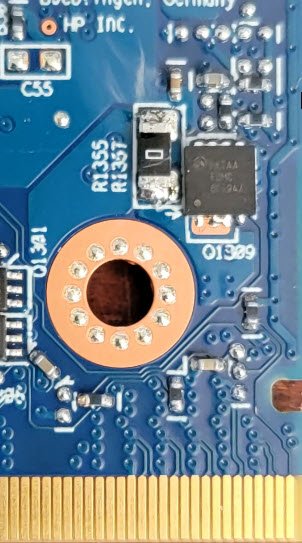** NVIDIA Quadro K4100M Mac Edition ROM **
Genuine Native Boot Screen & Brightness Control
View attachment 942198
After much testing and research, I've put together a ROM for the
NVIDIA Quadro K4100M which will allow:
- Genuine native brightness control
- Genuine ‘gray’ early-boot screen
- Genuine macOS bootloader compliance
Requirements:
BACKUP YOUR ORIGINAL ROM before doing anything!
iMac12,2 (27-inch Mid 2011) Mac-942B59F58194171B (Tested machine)
BootROM:
87.0.0.0.0. Please use High Sierra to update your BootROM to latest version.
GPU Variant: N15E-Q3-A2
Dell K4100M vbios: 80.04.E8.00.1D
HP K4100M vbios: 80.04.E8.00.22
tested card with the following vram:
View attachment 1729324 View attachment 1743819
This ROM does not require a 3rd party bootloader like OpenCore.
This is an alternative ROM and mainly for the audience that just want a “drop-in” answer to upgrading their video card on the iMac 2011. I appreciate the ongoing ROM testing done by
@Ausdauersportler,
@highvoltage12v. With their efforts we can expand its utility across multiple macOS versions and peripherals.
Brightness Control Stepping Modifcation:
-Turn computer on, hold down Command(⌘)-R
-Choose Utilities > Terminal
-Enter:
csrutil disable
-Reboot
-
MacOS Catalina: requires you to make root writeable:
sudo mount -uw /
-You can download 'Hackintool v3.05' , navigate to
View attachment 1823642 menu, use the
View attachment 1823641 icon at the bottom to disable gatekeeper and mount the disk in read/write mode.
-Download and open 'Kext Utility v2.6.6'
-Navigate to S/L/E (System/Library/Extensions)
-Copy "AppleBacklight.kext" to Desktop
-Edit:
AppleBacklight.kext/Contents/Info.plist
-Scroll down to:
IOKitPersonalities > AppleIntelPanelA > ApplePanels
-There you find several Apple LCD profiles.
-For the iMac 2011 27" machine locate:
Code:
<key>F10Ta007</key>
<data>
ABEABgALABQAHAAnADMAPwBOAFwAZwBzAIEAkQClAL8A2wD/
</data>
-Change the <data> section to:
ABEAAgA3AF8AigCzAOsBJAFnAakB1AIJAlQCogL4A00DlgRpBGk=
-Drag your modded kext into Kext Utility, allow it correct permissions
-Applebacklight.kext.bak folder will be created
-Reboot
The above data pattern will allow for a wider span of steppings for the brightness control and utilizes more of the capacity of the HD3000. If you have a different machine, your panel ID can be found by going to
System Preferences > Displays > Color > Open Profile > mmod
This rom does not require the use of an external EDID parser or a separate graphics core-console stack module, but I’ve left them in there for now. It uses a built in EDID_override_Protocol, a UGA_protocol and GOP_protocol. The rom is based on a TianoCore EDK2 build which houses its own generic video driver. During bootup, the efiROM is responsible for video rendering before the control is seamlessly transferred off to a different handle, the macOS video drivers. This is known as pre-boot configuration.
Caveats post-install/Bugs:
-16bit resolution glitch of UGA_DRAW_PROTOCOL - temporary solution: activate a sleep cycle and return, this should now clear the issue.
warning: as stated previously these cards are based on a WSON flash package and therefore are much more difficult to recover from a bad flash. Please take precautions and verify flashing.
In the words of Steve Jobs, “
this is insanely great!”
files:
K4100M_BR.rom -
stable with mem:2000Mhz, TDP:862Mhz
K4100M_UGA.rom -
overclocked with mem: 2200Mhz, TDP: 967Mhz
K4100M_AFR.rom - for -AFR based cards
******
UPDATE
******
09 02 2021: working on Catalina 10.15.7
07 02 2021: tested stability @2200Mhz & 967Mhz, thank you @Ri7 for testing, K4100M_UGA
09 08 2020: working on BigSur!
11 11 2020: working on High Sierra 10.13.6, security update 2020-006
24 09 2020: working on High Sierra 10.13.6, security update 2020-005
21 07 2020: working on Mojave 10.14.6, security update 2020-004 (18G6020)
20 07 2020: working on High Sierra 10.13.6, security update 2020-004
20 07 2020: working on Catalina 10.15.4
20 07 2020: working on Catalina 10.15.6 + kext mods



